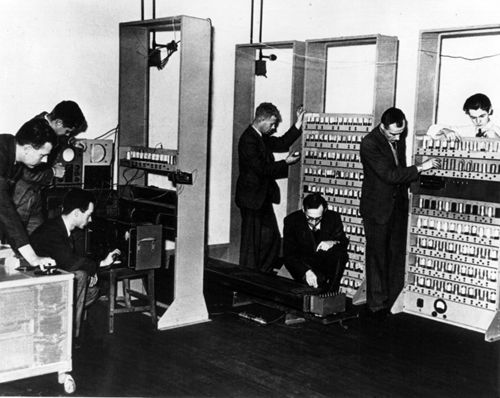| On This Day In 1949 EDSAC Performs Stored Program Calculation |
| Written by Sue Gee | |||
| Friday, 06 May 2022 | |||
|
On May 6, 1949 EDSAC entered into computer history by performing its first calculation. Built immediately after World War II at the University of Cambridge, England under the direction of Sir Maurice Wilkes the Electronic Delay Storage Automatic Calculator has the status of being the first practical stored-program computer.
While earlier computers were typically dedicated to a single task that was built into their hardware EDSAC was intended to be a general purpose computer that would be used by scientists, mathematicians and engineers doing a wide range of research that required time-consuming calculations. After the initial successful program run it was soon in everyday service at the University of Cambridge Mathematical Laboratory and provided a computing service there for over nine years, until it was superseded by EDSAC 2. In this video produced by Google in 2013 to celebrate the 64th anniversary of EDSAC's initial run, people who were EDSAC's computer users recorded their memories:
As was the fate of many other early computers, no attempt was made to preserve EDSAC for posterity. However, thanks to the efforts of the UK's Computer Conservation Society a replica has been painstakingly created. This work has been done by a dedicated team of number of volunteers, many of whom, now in their 70s and 80s had experience of the valve-based technology used by EDSAC. Most of the work was undertaken in full public gaze at the UK's National Museum of Computing (TNMOC) located in the grounds of Bletchley Park, Britain's wartime code-cracking centre and therefore regarded as the "home of computing" in the UK. The rebuild project started in 2011 and was initially expected to take 4 years. It was hampered by lack of documentation. With almost no original design documents remaining, the rebuild volunteers had to scrutinize photographs to puzzle out where and how components fitted together, However, as we reported in 2014, three years into the project a set of 19 detailed circuit diagrams were donated to the team. These diagrams certainly aided progress of the project bu tit took longer than initially expected and a new completion date of late 2019 was set. Even that had to be extended and when TNMOC had to be shut down because of COVID, some of the volunteers working on the intricate wiring of the individual chassis making up the replica took them home to continue the task. The latest report from the project states: The EDSAC replica is now close to 100% physically complete, and we are in a very active commissioning phase – debugging the individual chassis and testing sub-systems. This inevitably involves making changes to some circuits and individual components. Probably the most challenging issue revolve around shaping and timing of pulses. As well as putting out a plea for funding the post also ask for volunteers: Most of our team of volunteers are well past retirement age, as only people of that vintage have the necessary background in designing and building valve-based circuits. We now need to recruit a younger generation of volunteers with electronics skills who can work alongside the current team to “learn EDSAC” and be able to maintain it in the longer term and perhaps also to demonstrate it to the public as a living, working historical artefact.
Maurice Wilkes and the EDSAC1
More InformationRelated ArticlesEDSAC Celebrated 64 Years After First Run EDSAC Display Officially Opened EDSAC Reconstruction Demoed To Celebrate Wilkes Centenary
To be informed about new articles on I Programmer, sign up for our weekly newsletter, subscribe to the RSS feed and follow us on Twitter, Facebook or Linkedin.
Comments
or email your comment to: comments@i-programmer.info
|
|||
| Last Updated ( Friday, 06 May 2022 ) |



